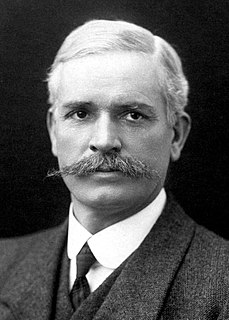
Andrew Fisher was an Australian politician who served three terms as prime minister of Australia – from 1908 to 1909, from 1910 to 1913, and from 1914 to 1915. He was the leader of the Australian Labor Party (ALP) from 1907 to 1915.

Sir Joseph Cook, was an Australian politician who served as the sixth Prime Minister of Australia, in office from 1913 to 1914. He was the leader of the Liberal Party from 1913 to 1917, after earlier serving as the leader of the Anti-Socialist Party from 1908 to 1909.
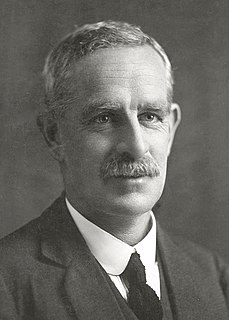
Francis Gwynne Tudor was an Australian politician who served as the leader of the Australian Labor Party from 1916 until his death. He had previously been a government minister under Andrew Fisher and Billy Hughes.

The Watson Ministry (Labour) was the 3rd ministry of the Government of Australia, and the first national Labour government formed in the world. It was led by the country's 3rd Prime Minister, Chris Watson. The Watson Ministry succeeded the First Deakin Ministry, which dissolved on 27 April 1904 after Labour withdrew their support and Alfred Deakin was forced to resign. The ministry was replaced by the Reid Ministry on 17 August 1904 after the Protectionist Party withdrew their support over the Conciliation and Arbitration Bill.
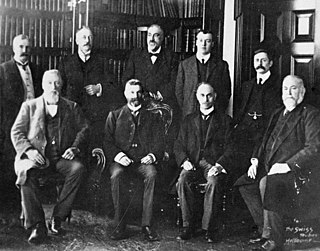
The Second Deakin Ministry (Protectionist) was the 5th ministry of the Government of Australia. It was led by the country's 2nd Prime Minister, Alfred Deakin. The Second Deakin Ministry succeeded the Reid Ministry, which dissolved on 5 July 1905 following the resignation of George Reid after the Protectionists withdrew their support and gained support from the Labour Party. The ministry was replaced by the First Fisher Ministry on 13 November 1908 after the Labour Party withdrew their support and formed their own minority government.

The Third Deakin Ministry was the 7th ministry of the Government of Australia. It was led by the country's 2nd Prime Minister, Alfred Deakin. The Fourth Deakin Ministry succeeded the First Fisher Ministry, which dissolved on 2 June 1909 after the Protectionist Party and the Anti-Socialist Party merged into the Commonwealth Liberal Party "fusion" and withdrew their support in order to form what became the first majority government in federal Australian history. The ministry was replaced by the Second Fisher Ministry on 29 April 1910 following the federal election that took place on 13 April which saw the Labour Party defeat the Commonwealth Liberals.
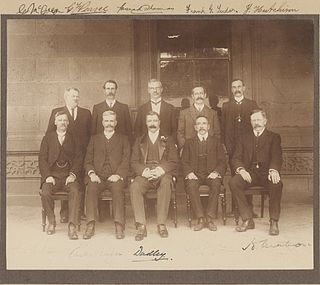
The First Fisher Ministry (Labour) was the 6th ministry of the Government of Australia. It was led by the country's 5th Prime Minister, Andrew Fisher. The First Fisher Ministry succeeded the Second Deakin Ministry, which dissolved on 13 November 1908 after Labour withdrew their support and Alfred Deakin was forced to resign. The ministry was replaced by the Third Deakin Ministry on 2 June 1909 after the Protectionist Party and the Anti-Socialist Party merged into the Commonwealth Liberal Party "fusion" and withdrew their support in order to form what became the first majority government in federal Australian history.
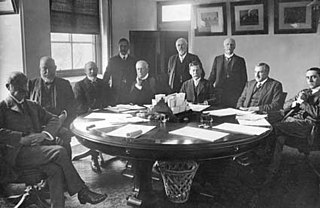
The Cook Ministry was the 9th ministry of the Government of Australia. It was led by the country's 6th Prime Minister, Joseph Cook. The Cook Ministry succeeded the Second Fisher Ministry, which dissolved on 24 June 1913 following the federal election that took place in May which saw the Commonwealth Liberals defeat Andrew Fisher's Labor Party - albeit with a one-seat majority. The ministry was replaced by the Third Fisher Ministry on 17 September 1914 following the federal election that took place on 5 September which saw Labor defeat the Commonwealth Liberals.

The Second Hughes Ministry was the 12th ministry of the Government of Australia. It was led by the country's 7th Prime Minister, Billy Hughes. The Second Hughes Ministry succeeded the First Hughes Ministry, which dissolved on 14 November 1916 following the split that took place within the governing Labor Party over the issue of conscription. This led to Hughes and his supporters leaving the party to form the National Labor Party, which swiftly received parliamentary support from Joseph Cook and the Commonwealth Liberal Party. The ministry was replaced by the Third Hughes Ministry on 17 February 1917 after National Labor and Commonwealth Liberal merged into the Nationalist Party.
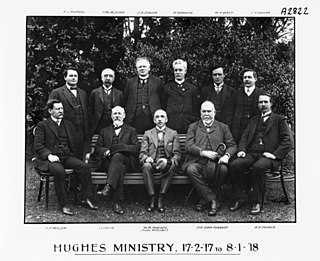
The Third Hughes Ministry (Nationalist) was the 13th ministry of the Government of Australia. It was led by the country's 7th Prime Minister, Billy Hughes. The Third Hughes Ministry succeeded the Second Hughes Ministry, which dissolved on 17 February 1917 after the governing National Labor Party merged with the Commonwealth Liberal Party to form the Nationalist Party. The National Labor Party itself formed as a consequence of the split that took place within the then-governing Labor Party over the issue of conscription. The ministry was replaced by the Fourth Hughes Ministry on 8 January 1918 following the resignation of Hughes as Prime Minister after a vote of no-confidence within the Nationalist Party in the wake of a failed second referendum on conscription. However, due to a lack of alternative leaders, Hughes was immediately re-commissioned as Prime Minister by Governor-General Sir Ronald Munro Ferguson.

The Fourth Hughes Ministry (Nationalist) was the 14th ministry of the Government of Australia. It was led by the country's 7th Prime Minister, Billy Hughes. The Fourth Hughes Ministry succeeded the Third Hughes Ministry, which dissolved on 8 January 1918 following the resignation of Hughes as Prime Minister after a vote of no-confidence within the Nationalist Party in the wake of a failed second referendum on conscription. However, due to a lack of alternative leaders, Hughes was immediately re-commissioned as Prime Minister by Governor-General Sir Ronald Munro Ferguson. The ministry was replaced by the Fifth Hughes Ministry on 3 February 1920 following the 1919 federal election.

The Fifth Hughes Ministry (Nationalist) was the 15th ministry of the Government of Australia. It was led by the country's 7th Prime Minister, Billy Hughes. The Fourth Hughes Ministry succeeded the Fourth Hughes Ministry, which dissolved on 3 February 1920 following the federal election that took place in December. The ministry was replaced by the First Bruce Ministry on 9 February 1923 following the 1922 federal election and the subsequent resignation of Hughes as Prime Minister.

The First Bruce Ministry was the 16th ministry of the Government of Australia. It was led by the country's 8th Prime Minister, Stanley Bruce. The First Bruce Ministry succeeded the Fifth Hughes Ministry, which dissolved on 9 February 1923 following the December 1922 federal election and the subsequent resignation of Billy Hughes as Prime Minister. The Nationalists had lost their majority in the election, and had no choice but to negotiate a Coalition deal with the Country Party. However, Country leader Earle Page let it be known that no deal could be made unless Hughes resigned. It is the first ministry that consists of a centre-right Coalition between the senior conservative party and the junior rural party - this Coalition has more or less endured to this day with the modern-day Liberal Party and National Party. The ministry was replaced by the Second Bruce Ministry on 18 December 1925 following the 1925 federal election.
The Second Bruce Ministry was the 17th ministry of the Government of Australia. It was led by the country's 8th Prime Minister, Stanley Bruce. The Second Bruce Ministry succeeded the First Bruce Ministry, which dissolved on 18 December 1925 following the federal election that took place in November. The ministry was replaced by the Third Bruce Ministry on 29 November 1928 following the 1928 federal election.
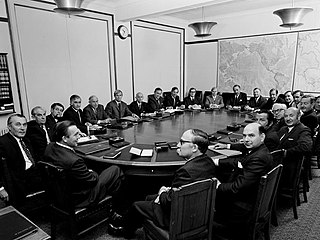
The McMahon Ministry was the 46th ministry of the Government of Australia. It was led by the country's 20th Prime Minister, William McMahon. The McMahon Ministry succeeded the Second Gorton Ministry, which dissolved on 10 March 1971 following the resignation of John Gorton as Prime Minister. The ministry was replaced by the First Whitlam Ministry on 5 December 1972 following the federal election that took place on 2 December which saw Labor defeat the Coalition.
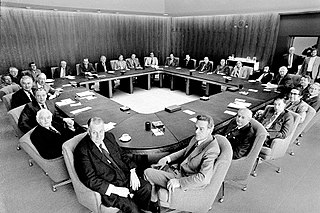
The third Whitlam ministry (Labor) was the 49th ministry of the Government of Australia. It was led by the country's 21st Prime Minister, Gough Whitlam. The third Whitlam ministry succeeded the Second Whitlam ministry, which dissolved on 12 June 1974 following the federal election that took place in May. The ministry was replaced by the First Fraser Ministry on 11 November following the dismissal of the Whitlam government by the Governor-General, Sir John Kerr.
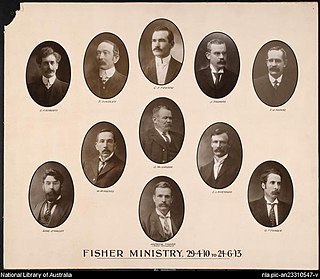
The Second Fisher Ministry was the 8th ministry of the Government of Australia. It was led by the country's 5th Prime Minister, Andrew Fisher. The Second Fisher Ministry succeeded the Third Deakin Ministry, which dissolved on 29 April 1910 following the federal election that took place on 13 April which saw Labor defeat the Alfred Deakin's Commonwealth Liberal Party. It is the first federal government in Australian history to be elected with a majority in the House of Representatives, as well as the first majority national Labor government in the world. The ministry was replaced by the Cook Ministry on 24 June 1913 following the federal election that took place in May which saw the Liberals defeat Labor.
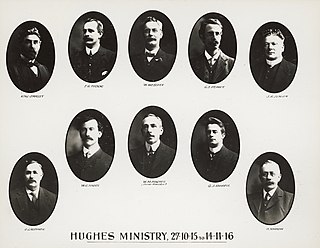
The First Hughes Ministry (Labor) was the 12th ministry of the Government of Australia. It was led by the country's 7th Prime Minister, Billy Hughes. The First Hughes Ministry succeeded the Third Fisher Ministry, which dissolved on 27 October 1915 following Andrew Fisher's retirement from Parliament to become the next High Commissioner to the United Kingdom. The ministry was replaced by the Second Hughes Ministry on 14 November 1916 following the split that took place within Labor over the issue of conscription. This led to Hughes and his supporters leaving the party to form the National Labor Party.

Sir George Foster Pearce KCVO was an Australian politician who served as a Senator for Western Australia from 1901 to 1938. He began his career in the Labor Party but later joined the National Labor Party, the Nationalist Party, and the United Australia Party; he served as a cabinet minister under prime ministers from all four parties.

William Henry Kelly was an Australian politician. He served in the House of Representatives from 1903 to 1919, and served as an honorary minister under Prime Minister Joseph Cook from 1913 to 1914.






























